Located on the banks of the Guadalquivir River, Seville is the heir of a rich Arab legacy and its prosperous commercial port with the Americas.
The Andalusian capital distills joy and bustle in each of the streets and squares that make up its historic quarter, which houses an interesting set of buildings declared World Heritage and neighborhoods of deep popular flavor, such as Triana or La Macarena.
Seville is an outstanding business and service centre in the south of the peninsula, with a wide range of hotel beds distributed throughout the city centre, which will allow you to discover the countless attractions of the city. Museums and art centres, theme parks, cinemas, theatres and nightclubs are just some of the endless leisure possibilities that a great city like Seville has to offer. All this without forgetting the numerous terraces, taverns and bars where you can practice one of the most deep-rooted and tasty customs of the city:"tapeo".
Another good excuse to visit the capital of Seville is its festivities. Declared of International Tourist Interest, Easter and the April Fair reflect the devotion and folklore of the Sevillian people, always open and cordial with the visitor. But Seville is much more, as it is a good starting point to travel throughout the province through the most diverse cultural routes, such as the Roman Betica Route or the Washington Irving.
You can also discover the enormous natural richness of a region that straddles two continents, with treasures such as the Doñana Natural Park, World Heritage Site and Biosphere Reserve by UNESCO, or the Sierra Norte Natural Park. They will be the ideal setting for all kinds of outdoor sports, including hiking, horse riding and cycling. But if the sport we practice is golf, Seville has four excellent courses in the vicinity of the city.
Seville: Gastronomy
The sevillian gastronomy has evolved with the internal and external stimuli that, throughout different times have provided and enriched the numerous people that lived here. Iberian, celts, phoenicians, greek, roman, jewish, goths and muslims have contributed to create the present history of the sevillian gastronomy. They all contributed to uses and customs that have persisted at times until the present time.
Modern cookery is mainly based on the now world-wide well-known “Mediterranean Diet” which consists mostly in taking advantage of all the products that our excellent land and wonderful coasts provide us with.
Whoever arrives in seville for the first time will be astonished by the great variety of establishments in which to enjoy an excellent proper meal or else to “tapear”, a very extended custom among its people.
“Tapas” are most popular in our gastronomy. They consist in small portions of either cold or warm food served with a drink before the main meal.
Each establishment tries to offer its original “tapas”, and in this way visitors can discover new flavours and seasoned products. It is thanks to these small portions that one becomes familiar with sevillian cooking.
We shouldn’t either leave the city without trying in restaurants the famous “fresh fish” in all its variety from the very popular “boquerones” or small fried fish to sea bass, sea bream, urta, dogfish, seafood, swordfish, etc. all of it coming from our near by coasts.
To go along with all this we must try the exquisite and local unfermented grape-juice “mosto”, the already famous sevillian beer or the also world-wide known fine winesand manzanilla from Sanlúcar.
Tapas in Seville
Sevillians go out for "tapas" in the evening as an alternative to having dinner in a restaurant and they do the same for lunch at midday.
“Tapas” are small amounts of any type of andalusian food and normally people take one “tapa” with each drink. Sometimes people also order a “ration” to share and everybody eats frome the same plate placed in the middle of the table.
To eat tapas people may sit down at a table or stand up by the bar or small auxiliary high tables. Generally the list of tapas is written on a slate but in some bars waiters will recite the whole list by heart (which makes a bit difficult to remember them all). It is best to ask for “la carta” which is the “tapas” menu. Some bars have them translated into english as well.
Some of the most common covers are: Los Pinchitos morunos, Los Montaditos, El Gazpacho, El Pescado frito, Las Espinacas con garbanzos, El Menudo, Los Huevos a la flamenca, La Tortillitas de bacalao and La Ensaladilla
The Wine of Seville
Aunque Even though Seville is not a province that can boast a denomination of origin, nor is it a signifying zone in the world of viticulture the land and its people have a long and cultural tradition of wine.
The prestige of its wines is the result of a long winemaking tradition of years of aging of the most varied wines. Fine, amontillado, oloroso, sweet wines...
The wine of Montilla y Moriles is the result of a long evolution, the fruit of a complex and millenary creative process, the final conquest of a centuries-old work. The best wines from this appellation come from the vines planted in the rolling, limestone soils of the Sierra de Montilla and Moriles Alto, in other words, in the select albariza or albero vineyards.
The Pedro Ximénez takes its name from the variety of grape that it comes from. This variety is mainly characterized by its delicate skin and its high sugar content, which makes it reach 14º-15º at maturity. Once the grapes have been cut when they are ripe, they tend to be left in the sun in order to pass through. For several days, once the raisins have been processed, the final result is a wine of 22º beaumé and 9º of alcohol. It is a wine that, due to its fruity and pleasant taste, can be drunk as a dessert. Available with or without aging.
Monumentos en Sevilla
-
The Cathedral
-
Reales Alcázares
-
Archivo General de Indias
-
Town Hall of Seville
-
Los Caños de Carmona
-
The House of Pilate
-
House of the Province
-
San Fernando Cemetery
-
The Old Gates of Seville
-
Los Baños de la Reina Mora
-
Monument to Castelar
-
Monument to Zurbarán
-
Walls of Seville
-
Archeological Museum of Seville
-
Fine Arts Museum of Seville
-
San Telmo Palace
-
Maria Luisa Park
-
Bullring of Seville (La Maestranza)
-
Reales Atarazanas de Sevilla
-
Lope de Vega theatre
-
Templete del Triunfo
-
Tower of Abd-el-Aziz
-
Tower of Gold
-
Tower of Perdigones
-
Tower of Silver
-
University of Seville
-
Charity Hospital
The Cathedral
Plaza Virgen de los Reyes - +34 954 56 33 21
The Cathedral of Seville is the largest gothic cathedral in the world, and the third temple in size after St. Peter's Basilica of the Vatican in Rome, and St. Paul in London. In 1987 it was declared a World Heritage Site by UNESCO.
The Cabildo Metropolitano has been the custodian of its rich history for seven centuries and wants to remain as it, every day with a more modern and accurate focus and organization. To do so it maintains the daily Liturgy and the celebration of the great feasts of Corpus and Inmaculada, handles devotion to the Virgen de los Reyes permanently, and makes extensive sacramental pastoral, as the first church in the Diocese of Seville.

Reales Alcázares of Sevilla
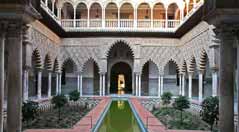
Patio de Banderas s/n. - +34 954 50 23 24
A citadel is a Spanish castle. Etymologically, the word comes from Arabic fortress at Qasr ????? which means' strength ', which is in Latin castellum (castrum). Several Spanish cities have an alcazar.
The Alcazar of Sevilla is used as a place of accommodation for members of the Royal Family and dignitaries who visit the city. It consists of several buildings of different eras. The original fortification was built on an ancient Roman settlement, and later Visigoths. Later became a basilica Paleo (San Vicente Martir), where he was buried San Isidoro.
Archivo General de Indias de Sevilla
Avda de la Constitucion
Built by the initiative of the chapter cathedral, in request to the King Felipe II, it was realized between the year 1583 to 1646, initially as Casa de la Lonja (exchange market)(XVIth century). In the works, project of Juan Herrera, took part the architects Juan de Minjares and Alonso de Vandelvira.
In 1660 the building sheltered Seville’s Fine Arts Academy, and its first president was the painter Murillo, together with Herrera del Pozo. Later it was presided by the illustrious painter Juan Valdés Leal.
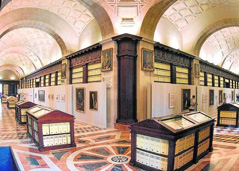
Town Hall of Seville
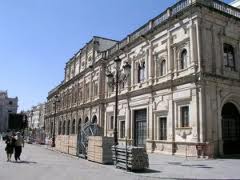
C/ Judíos - +34 957 20 29 28
The facade of the Plaza de San Francisco presents us with doors and windows decorated with medallions of mythological and historical. The pillars are decorated with floral bouquets and grotesque.
On this side of the building is the (Arquillo (who announced the Plaza de San Francisco with the Plaza Nueva. The two sides of Arquilla, a medium altitude, are two niches with statues, one of Hercules, (Phoenician sailor and then considered mythological god) who is credited with founding the city of Seville and the other is the statue of Julius Caesar, who restored and amuralló the city. Both are listed in this place of honor to be considered as the Fathers of the Fatherland Hispalense. The facade of City Hall that gives the Plaza Nueva is modern and of little architectural interest.
Inside the building is remarkable the Chapter House, whose roof is made up of a vault with 35 coffered almost flat stone bearing in relief portraits of the kings of Spain prior to Philip II. It is also notable that the ladder from the halt rises to the top floor of mixed Gothic and Renaissance style.
The building is rich in old paintings of great masters, as well as sculpture, stained glass and other art treasures.
Los Caños de Carmona
Puerta de Carmona
The Caños de Carmona, are a few remains of a Roman aqueduct that existed in Seville that were still used unt to its demolition in 1912.
They used for its construction only bricks as material, and it had approximately 400 arches on pillars on the side that everyone could see, and in some of the parts with a top floor also made with arches, and it seems to be the only one in Spain.
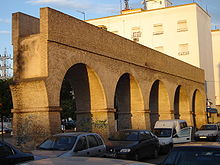
The House of Pilate
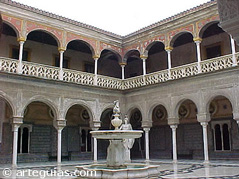
Plaza de Pilatos 1 - +34 954 22 52 98
The House of Pilate, or Palace of Medinaceli, is a palace in Seville (Andalusia, Spain), built a mixture of Italian Renaissance styles and the Mudejar Spanish. It is seen as a prototype of the Andalusian palace.
The House of the Province
Plaza del Triunfo, 1 - +34 954 22 28 70
Variety of activities, variety of disciplines. From Easter until Dew, going through the patron festivals, festivals, dining and tourist routes, natural landscapes or socioeconomic traditional uses. From painting to pottery or crafts. Each custom, each trend that is part of our cultural heritage or is the latest cutting edge, is characterized and singled in each of our exhibitions.
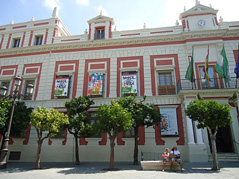
The San Fernando Cemetery
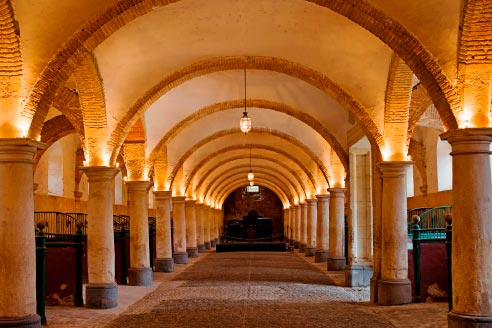
Avd. Sánchez Pizjuan, s/n. Cemetery Roundabout - +34 954 90 29 59
The walled enclosure known of the Jewish Château is located in the city of Cordoba, capital of province of the same name, limiting the east by the precincts of the Medina, on the west Alcazar in the area of the Old and in the south of the Alcazar los Reyes Cristianos.
The Old Gates of Seville
Each door has its corresponding location
To access the city, the walls counted along history with 19 doors or shutters, a number of other public and private. The urban fabric of the city is developing in the vicinity of the doors open to the public, which entered the goods.
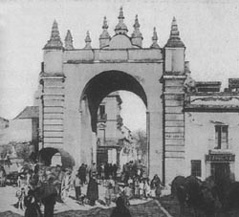
Los Baños de la Reina Mora
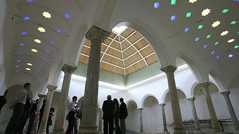
Between the street Baños y Miguel Cid. Barrio de San Vicente
They are located in the middle of San Vicente neighbourhood, between calle Baños and calle Miguel Cid, next to Dulce Nombre de Jesús Chapel, belonging to Vera Cruz Brotherhood, co-owner of these hammams (arab baths).
These baths suffered excavations to delimitate the monumental ensemble in 1983 and 1984, but today they are already restored.
The Vera Cruz Brotherhood, achieved that the Baños de la Reina Mora were recuperated for Seville, thanks to the Junta of Andalucía and the Town Hall of Seville. Now it is restored you can assist to an evening of classical and chamber music and it can be culturally visited for three days a week.
Monument to Castelar
Los Jardines del Cristina. Between the Tower of Gold and the Puerta de Jerez
The idea of erecting a monument or a statue to the great Republican began in 1903 with the intention even to open a popular subscription to cover the costs of this work. However, nobody mentioned it again until January 1927, when the editor of "The Liberal", D. Luis Rojas claimed in a newspaper article "Castelar does'nt have a monument in Seville!". But it would have to wait another year to develop an enthusiasm for this politician and his sculpture. The sevillian newspaper opened a public subscription and began to set the chain leading to the construction of this monument.
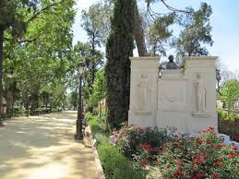
Monument to Zurbarán
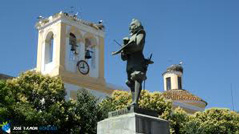
Plaza de Pilatos
The statue dedicated to the painter Zurbaran, is located in the Plaza de Pilatos. It was conducted in 1929 by Aurelio Cabrera Gallardo. At first it was located in the Maria Luisa Park, and was moved to its current location in 1950.
On the pedestal there are four bas relief with the shield of Fuente de Cantos, where the sculptor was born, the Tower of Gold, Santa Casilda (Zurbaráns painting) and the Arc of la Macarena.
Walls of Seville
They covered a large perimeter of Seville, currently only preserved in the Barrio de la Macarena and the Alcazar
There were seven kilometers of walls, with 166 towers, 12 gates and 3 shutters. This magnificent work was conserved in its totality until 1868, revolution toppled it almost for complete, being conserved nowadays the Murallas de la Macarena (Walls of Macarena), in Macarena Quarter, that counts with seven square towers and an hexagonal one, some tranches in the Parque del Valle (the Valley Park) and the rest in the Alcázar.
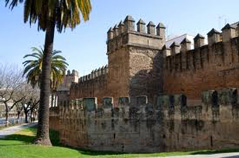
Archeological Museum of Seville
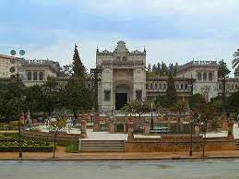
Plaza de América ("Plaza de las Palomas"), Maria Luisa Park
The Archaeological Museum of Seville is located in front of the Arts and Popular Customs Museum (old Mudejar Pavilion) and next to the Royal Pavilion, all in the Plaza of America (popularly known as “Plaza de las Palomas”), located as well in the Park of Maria Luisa.
The building was destined to be the Fine Arts Palace in the Latin American Exhibition of 1929.
It was projected by Aníbal González and built between 1910 and 1915 in a Neon-Renaissance style. The archaeological collections are transferred to the building in 1942, before they were in the old Convent of la Merced, building that lodges the Fine Arts Museum of Seville.
Fine Arts Museum of Seville
Plaza Museo - +34 954 22 18 29
The Archaeological Museum of Seville is located in front of the Arts and Popular Customs Museum (old Mudejar Pavilion) and next to the Royal Pavilion, all in the Plaza of America (popularly known as “Plaza de las Palomas”), located as well in the Park of Maria Luisa.
The building was destined to be the Fine Arts Palace in the Latin American Exhibition of 1929.
It was projected by Aníbal González and built between 1910 and 1915 in a Neon-Renaissance style. The archaeological collections are transferred to the building in 1942, before they were in the old Convent of la Merced, building that lodges the Fine Arts Museum of Seville.
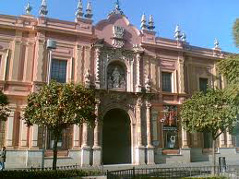
San Telmo Palace
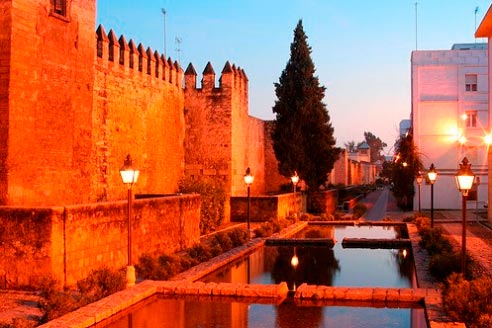
Avenida de Roma S/N. - +34 955 03 55 00
It is one of the most representative buildings in the capital city of Seville.
This baroque building is the headquarters of the current presidency of the autonomous region but this was not its main function. Began as the University of dizzying in 1682, then became the College of Nautical Education (1849), then was the private residence of the Dukes of Montpensier and finally, Diocesan Seminary (1901).
Maria Luisa Park
Avenida de Isabel La Católica
First these gardens were part of the ones in the Palacio de San Telmo and then were donated in 1893 by the Infanta Maria Luisa Fernanda de Orleans (Duchess of Montpensier) to the city. It was renovated by French engineer Jean Claude Nicolas Forestier, curator of the Boulogne Forest in Paris, who gave a romantic touch, inspired by the gardens of the Generalife, the Alhambra and the Reales Alcázares de Sevilla. The squares of Spain and America were opened in the park, and they are some of the main attractions. It was inaugurated on April 18, 1914.
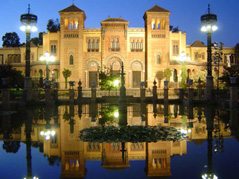
Bullring of Seville (La Maestranza)
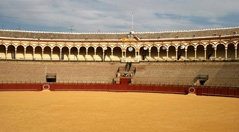
Paseo de Cristóbal Colón, 12 - +34 954 22 45 77
The Bullring of the Real Maestranza de Caballería de Sevilla (Royal Arsenal of Cavalry of Seville) is considered like one of the older bullfighting enclosures for bullfighting of Spain. It is the seat of the bullfights realised in the city, having special relevance for the fans those that are celebrated during the "Feria de Abril" (Fair of April). It is considered one of the most popular tourist attraction centers of the city and one of the most visited monuments. It has a capacity for 12,500 localities.
Reales Atarazanas de Sevilla
C/ Temprado 1, street corner Dos de Mayo. Behind the theater of la Maestranza. - +34 954 98 39 18
The Royal Atarazanas was the Almohade entrance system to the city of Seville, that represented an increase in the number of obstacles to save in case of siege.
Its location in the highest area of the environment, along with the advancement of the lines at the stake, fulfilled to perfection the major defensive guidelines.
This entrance solution to the city was abandoned with the building of the Christian Atarazanas. Not so their structures, which continued in use until the end of the fifteenth century.
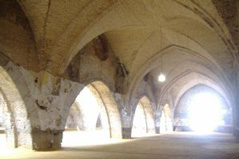
Lope de Vega theatre
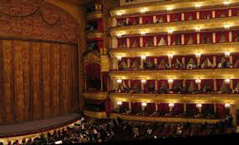
Avenida María Luisa S/N - +34 954 59 08 67
The Teatro Lope de Vega in Seville, is located in Avenida de Maria Luisa (next to the Parque de Maria Luisa), its construction dates from 1929 and its architect was Vicente Traver and Tomás, and it was, with the Casino, the Pavilion of the City of Seville for the Ibero-American Exposition held in that year.
Its architecture is Baroque, the building remains faithful to this style in the building and in its ornamentation. Scenic box, seats, stalls, stages, amphitheater and paradise, give a spectacular beauty to the theater, which has a capacity of one thousand one hundred people.
Templete del Triunfo
Plaza del Triunfo
Built in 1756, it is located in the Plaza del Triunfo, and it contains an image of a Madonna, Ntra. Sra. Patrocinio, on a baroque column, in commemoration of the good fortune of Seville during the earthquake of November 1st in 1755, known as the “earthquake of Lisboa", because its epicenter was located near this city and it had almost all destroyed.
A huge fire started and minutes after begun a tsunami, which extinguish the flames but destroyed nearly everything that was standing in the lower area of the city.
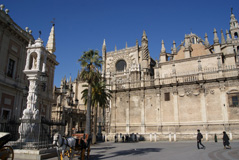
Tower of Abd-el-Aziz
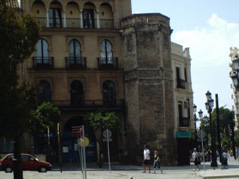
The corner of the street Santo Tomas with the Avenida de Constitucion
The Tower of Abd al-Aziz, better known as The Tower of Abdelaziz (emir established in Seville between the years 714 to 719, until he was murdered by his cousins)is an hexagonal tower, vertex of the city walls.
The walls of the Alcázar connected with this tower, towards the street of Santo Tomás, located in the corner with the Constitution Avenue, and from this tower started another wall, following along that Avenue towards the Puerta de Jeréz.
Only a few meters away there was an arch, called Arco de la Plata or Arco de la Victoria, also Almohad, culminating the fortress until the Puerta de Jerez, where began the defensive walls. From the Tower of Abd-el-Aziz started a second wall, in the direction of the street Santander, that connected with the Tower of Silver and Postigo del Carbón.
Tower of Gold
Pza. del Cardenal Salazar
Built in the first third of the XIIIth century, towards the end of the Taifas Kingdoms. Its name in Arab was Borg-al-Azajal, which came to express, that the golden tiling that flashed in the sun was like gold, and reflected in the river, could harm your eyes.
In 1220 Abu I Ula, the almohade governor, ordered to build it to defend the city. He also closed the entrance to the port with a heavy chain that crossed the river from this tower to another one that doesn’t exist anymore, in the border of Triana. This chain was broken by Ramon Bonifaz’s sailors in 1248 with the Reconquest’s fleet.
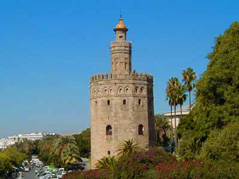
Tower of Perdigones
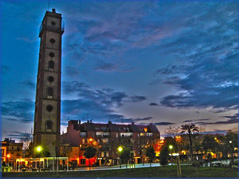
C/Resolana s/n - +34 954 90 93 53
Built in 1890, it was part of San Francisco de Paulas factory, property of the Mata family, and located at Resolana Street, in the Macarena Quarter.
This tower of 58 meters high, was used to produce lead bullets, because san Francisco de Paulas factory, this was its name, was a lead foundry factory, where they produced bullets, and even heat resistant bricks and zinc sheets.
Tower of Silver
Calle Santander
Its name means Tower of Silver, and it is located in Calle Santander. This tower is from the same epoch as the Torre del Oro (Tower of Gold), but it is much more modest respecting to its construction. It use to unite the walls of the Alcázar with the Torre del oro. Its construction is octogonal and has suffered many modifications most of all in the Middle Age period.
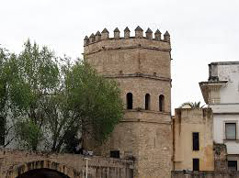
University of Seville

C/ S. Fernando, 4
The University of Seville is a public institution dedicated to high education, in the city of Seville, the Community of Andalusia. Although their centers are distributed all around the city, its rectorship is the building of the Royal Tobacco Factory. Before becaming the University of Seville, it was the School of Santa Maria de Jesus, founded by the Archdeacon Maese Rodrigo Fernandez de Santaella at the end of the XVth century.
Charity Hospital
Calle Temprado, 3 - +34 954 22 32 32
The Charity Hospital of Seville, is located in the district of the Arenal very close to the Maestranza Bullring, and it constitutes an architectonic and artistic set summit of the Spanish baroque art.
In 1644, because the old chapel was in ruin, is decided the construction of a new church according to plans of Pedro Sanchez Falconete. Miguel Mañara, chosen like older brother in 1663, became the main impeller of the project and made agile works on the temple. The plans of the Church were reformed on the initiative of Mañara and the facade was finished off by Leonardo de Figueroa.
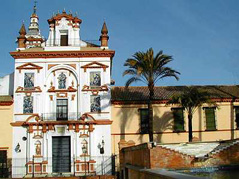
Hotels in Sevilla
Opinions
Estamos súper contentos después del tour con David! Ha sido súper simpático, nos ha contado todo al detalle y en todo momento nos ha mantenido atentos! Muchas gracias de verdad porque así da gusto hacer free tours!
Free Tour Sevilla
Hicimos el free tour con David, fue verdaderamente interesante y su manera de explicar fue muy divertida. Lo recomiendo totalmente.
Free Tour Sevilla
a. Es un tour muy interesante y ameno muy recomendable para conocer un poco más sobre la ciudad.
Free Tour Sevilla




